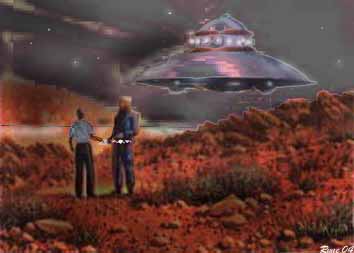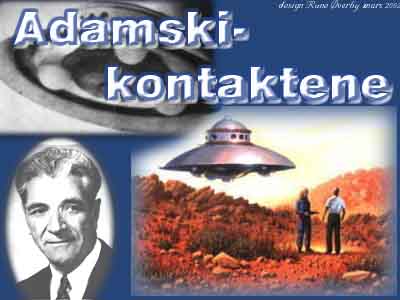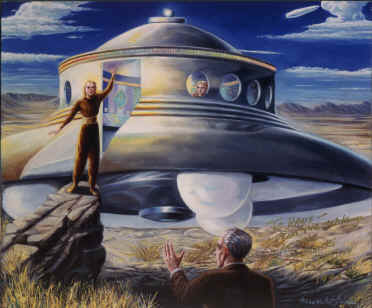The most tragic early life experience for Adamski was the death of his Polish father not long after emigrating to the U.S. with his Egyptian born wife, and the then four year old Adamski. Luckily, a mysterious tall dark family friend called Sid, took it upon himself to mentor the young Adamski who received private tuition. “Uncle Sid”, as he became affectionately known to the family, proposed that Adamski would benefit from further education in Tibet in “a monastery of Lamas. (p.22)” Adamski’s mother readily agreed with Uncle Sid’s unusual proposal. At the significant age of 12, the age when most rites of passage are performed for young men, Adamski was taken to Tibet. He spent somewhere between three to six years learning Buddhist philosophy at the hands of Tibetan Lamas, and/or “Masters of Wisdom” as Aartsen describes them. Who was “Uncle Sid” that would provide for Adamski’s expenses and guidance for such an unconventional formative childhood education? According to Aartsen, and unknown to Adamski, Uncle Sid was himself one of the space brothers that Adamski would later famously meet and befriend in 1952.
After his return from Tibet to the U.S. Adamski had acquired some very unconventional abilities from his time with his Tibetan teachers who taught him to “master the four elements: fire, water, air and earth” (p. 22). His newly acquired abilities were demonstrated to some Adamski trusted, but Adamski played down such abilities as insignificant compared to the philosophy he had learned in Tibet. Aartsen cites another author Henry Dohan who explained further Adamski’s reasoning: "the people who were around Adamski and who knew of his unusual powers were asked to keep it a secret. Adamski thought it would prejudice his prestige as a teacher, as people would take him for a magician" (p. 22).
Some time in this period of the 1930’s Adamski established the “Royal Order of Tibet” and a monastery at Laguna Beach, California. He therefore became one of the first people in the U.S. to teach esoteric practices and philosophy that had been learned at first hand from Tibetan Lamas. Adamski’s first book followed soon after in 1936 and was titled Wisdom of the Masters of the Far East. In it he elaborated on what he had learned in Tibet which he summarized in a 1934 interview with the Los Angeles Times where he said: “I learned great truths up there on the roof of the world, or rather the trick of applying age-old knowledge to daily life, to cure the body and the mind and to win mastery over self and soul” (p. 23).
So Adamski was clearly no opportunist who had conjured up a philosophy and established a cult around himself. He was in contrast, someone who had spent his formative childhood years directly learning with some of the world’s greatest teachers of esoteric practices and philosophies in Tibet. This is perhaps Aartsen’s greatest contribution in his book. Most critics of Adamski ignore or downplay the very significant experiences and teachings Adamski had acquired while in Tibet as a youngster. Instead, they launch into character assassinations where Adamski is portrayed as a self-promoting cultist who had no formal training for the esoteric practices and philosophies he was teaching. In contrast, Adamski’s childhood training and education was the ideal training for what he taught and practiced later in life.
In the late 1940’s and early 1950’s, Adamski began taking photos of UFOs, or flying saucers as they were known at the time. His flying saucer photos were among the finest ever taken and showed various types of craft – long cyclinder motherships, spheres of light, and the famous scout craft photos. Aartsen explains the famous 1952 Desert Center encounter with one of the space brothers. Orthon claimed to be from Venus and eventually Adamski would be taken to motherships from extraterrestrials from Venus and Saturn. Adamski claimed to have met on this motherships, Masters of Wisdom from both Venus and Saturn.
Aartsen describes the controversy arising from later NASA space probes showing extreme environmental conditions on Venus and Saturn that made human life as we know it impossible. While information from the early NASA missions was used to discredit Adamski’s claims of human life on other planets in our solar system, one thing that was overlooked was that life could exist on different dimensions. According to modern day string theory, as explained by Professor Michio Kaku, there are up to ten dimensions contained in space-time. So in the same space and time, one could encounter non-hospital life conditions in one dimension, and a flourishing civilization in another. Arguably, flourishing civilizations exist on Venus and Saturn today, but on a dimension that cannot be yet identified by scientific instruments.
Prior to Adamski’s death on April 23, 1965, Aartsen relates how Adamski promised that he would return as a young man to continue his earth mission. In an obituary, Lord Desmond Leslie, part of an English-Irish aristocratic family and co-author of Adamski’s first non-fiction book wrote: “I don’t believe by any means we have seen the last of him. If he is reborn on another planet, he has promised to come back and contact us when possible. (p. 28)” Incredibly, one day after his death, an Englishman by the name of Earnest Arthur Bryant had a contact experience with three extraterrestrials allegedly from Venus. Among them was one that the Englishmen remembered as being around 14 to 15 years old, Bryant wrote: “The youth appeared to be the leader of the group. He was more free and easy than the other two. ‘My name is Yamski’ he said (or at least sounded something like that). I was under the impression he was a Russian, except that he had a tendency towards an American accent, but when I asked where they had come from the reply was, ‘We are from Venus.’ Perhaps it was the look on my face, he turned to the others and said, ‘If only Des Les were here, he would understand.’ (p. 29)
Remarkably, the Venusian youth, ‘Yamski’ (a reincarnated Adamski?) went on to describe ‘Des Les’ in terms that made it clear he was referring to Adamski’s long time friend, Desmond Leslie. Incredibly, Bryant swore had no prior knowledge of George Adamski, let alone that he had died one day earlier.
Years later there was another incident that also seemed to fulfill Adamski’s promise of returning to Earth to help humanity accept the space brothers. An Italian contactee by the name of Giorgio Dibitonto claimed that in 1980 he and his companions met a young man from Venus whose name was George. Dibitonto described how a Venusian by the name of Raphael introduced him: “another man was introduced to us … ‘His name is George, said Raphael… This, our brother, lived for a while on Earth, where he chose to come on an assignment. Now he has returned to us” (p. 32).
Aartsen’s book will not satisfy the hardcore skeptic about the veracity of Adamski’s claims of contact with extraterrestrials from different planets of our solar system. Aartsen does, however, give important new insights into Adamski’s life and philosophy. For this reviewer, Adamski’s extended education in Tibet stands out as something out of the ordinary, and in itself a remarkable preparation for an extraordinary life. Adamski had certainly acquired experiences, philosophies and abilities that would later stand him in good stead as he confronted a skeptical world with his extraordinary claims of extraterrestrial contact. The best presentation of evidence supporting Adamski’s contactee claims is documented in a video which only recently resurfaced.
Aartsen’s succeeds admirably with his main aim of presenting information Adamski’s life, experiences and philosophy that many would not have known about. For this reader, George Adamski: Herald of the Space Brothers, is an open honest appraisal of someone who forever changed how our world would view extraterrestrial life. The idea of the benevolent human looking “space brothers” here to help educate and guide humanity has still not lost its appeal. This is despite the almost propagandist onslaught of non-human looking extraterrestrials abducting civilians for genetic experiments as portrayed by the mass media and many UFO researchers. Whether one agrees or not with Adamski’s contactee claims, what’s clear is that his childhood education in Tibet had prepared him well for the extraordinary events and teachings that he would later come to be known for around the world.
George Adamski: A Herald for the Space Brothers is available at Amazon.com
A rare video featuring evidence of supporting Adamski's claims appears here.
lyd om bl a Adamskikontaktene mp3
Further Reading;
"Adamski - had partly astral contacts - on 4d level"
‘George Adamski and the Toughest Job in
the World’-link
The Contactee Movement of the 1950s



